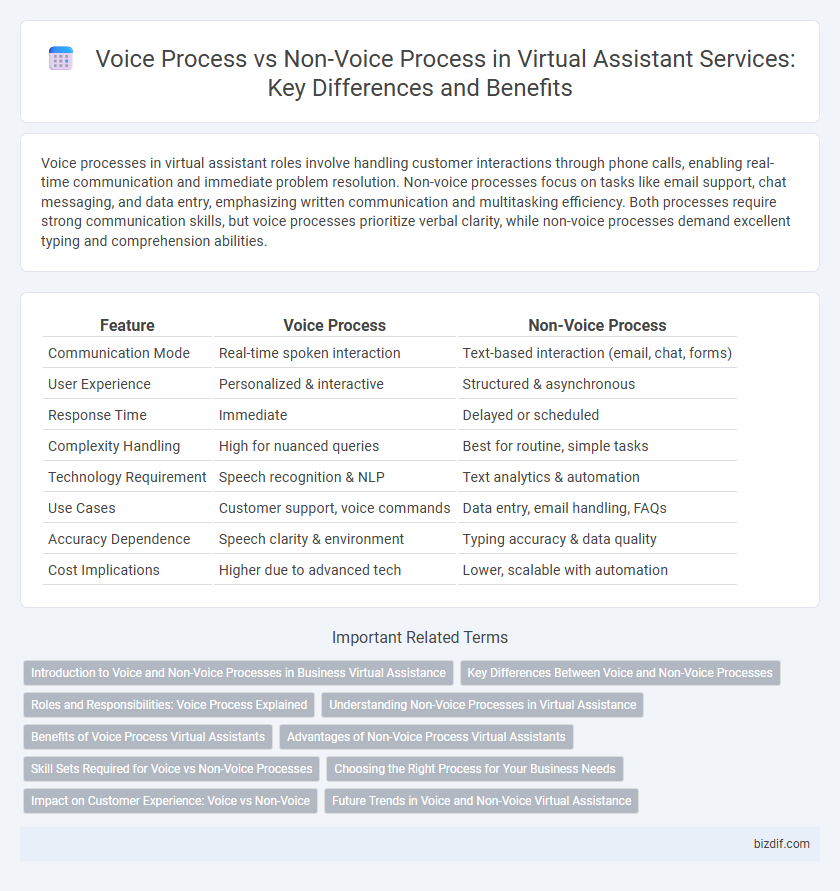Voice processes in virtual assistant roles involve handling customer interactions through phone calls, enabling real-time communication and immediate problem resolution. Non-voice processes focus on tasks like email support, chat messaging, and data entry, emphasizing written communication and multitasking efficiency. Both processes require strong communication skills, but voice processes prioritize verbal clarity, while non-voice processes demand excellent typing and comprehension abilities.
Table of Comparison
| Feature | Voice Process | Non-Voice Process |
|---|---|---|
| Communication Mode | Real-time spoken interaction | Text-based interaction (email, chat, forms) |
| User Experience | Personalized & interactive | Structured & asynchronous |
| Response Time | Immediate | Delayed or scheduled |
| Complexity Handling | High for nuanced queries | Best for routine, simple tasks |
| Technology Requirement | Speech recognition & NLP | Text analytics & automation |
| Use Cases | Customer support, voice commands | Data entry, email handling, FAQs |
| Accuracy Dependence | Speech clarity & environment | Typing accuracy & data quality |
| Cost Implications | Higher due to advanced tech | Lower, scalable with automation |
Introduction to Voice and Non-Voice Processes in Business Virtual Assistance
Voice processes in business virtual assistance primarily involve handling customer interactions through calls, enabling real-time problem-solving and personalized support. Non-voice processes focus on tasks like data entry, email management, and chat-based customer service that require written communication and multitasking skills. Both processes enhance operational efficiency, with voice processes driving direct engagement and non-voice processes supporting back-end workflows.
Key Differences Between Voice and Non-Voice Processes
Voice processes primarily involve handling customer interactions through spoken communication, such as inbound and outbound calls, requiring strong verbal skills and real-time problem solving. Non-voice processes focus on text-based tasks like email support, chat services, data entry, or content moderation, emphasizing typing proficiency and written communication clarity. Key differences include the mode of communication, response speed, and skill set, with voice processes demanding quick verbal responses and emotional intelligence, while non-voice relies on accuracy and multitasking in handling written information.
Roles and Responsibilities: Voice Process Explained
Voice process roles primarily involve direct customer interaction through phone calls, focusing on tasks such as handling inquiries, resolving complaints, providing product information, and conducting outbound sales or support calls. Responsibilities require strong communication skills, active listening, empathy, and the ability to manage stressful situations while maintaining a positive customer experience. Voice process agents must also document interactions accurately and follow predefined scripts or guidelines to ensure consistency and compliance with company policies.
Understanding Non-Voice Processes in Virtual Assistance
Non-voice processes in virtual assistance involve tasks such as email management, data entry, chat support, and social media handling, which do not require direct verbal communication. These processes enhance efficiency by leveraging written communication and automated tools to provide seamless support. Understanding the distinction between voice and non-voice tasks helps businesses optimize virtual assistant roles for improved customer experience and operational productivity.
Benefits of Voice Process Virtual Assistants
Voice process virtual assistants offer superior customer engagement through natural, real-time conversations that enhance user experience and increase satisfaction rates by up to 30%. These assistants improve efficiency by handling high volumes of calls simultaneously, reducing wait times and operational costs by approximately 40%. Their ability to understand and process speech nuances ensures accurate responses, boosting first-call resolution rates and overall productivity in customer service operations.
Advantages of Non-Voice Process Virtual Assistants
Non-voice process virtual assistants excel in handling text-based interactions such as email management, chat support, and data entry, providing higher accuracy and reducing misunderstandings common in voice communications. They offer flexible multitasking capabilities, enabling simultaneous management of multiple queries without the constraints of voice recognition errors or background noise. Enhanced privacy and discreet user interaction make non-voice virtual assistants ideal for professional environments and tasks requiring detailed documentation and record-keeping.
Skill Sets Required for Voice vs Non-Voice Processes
Voice processes demand strong verbal communication, active listening, and excellent pronunciation skills to handle customer queries effectively, alongside empathy and problem-solving abilities. Non-voice processes focus more on typing proficiency, data entry accuracy, analytical thinking, and written communication skills to manage emails, chats, and back-office tasks efficiently. Both roles require multitasking and time management, but the voice process places higher importance on real-time interaction capabilities.
Choosing the Right Process for Your Business Needs
Voice processes enhance customer engagement through real-time interactions, making them ideal for businesses requiring immediate issue resolution and personalized service. Non-voice processes, such as chat support and email handling, offer efficiency in managing high volumes of routine inquiries with detailed documentation and reduced operational costs. Selecting the right process depends on factors like customer interaction complexity, volume, and the desired balance between speed and accuracy.
Impact on Customer Experience: Voice vs Non-Voice
Voice process enables real-time interaction, allowing virtual assistants to understand intonation and emotion, which significantly enhances the personalization and immediacy of customer support. Non-voice processes, such as chat or email, offer detailed, traceable communication but may lack the emotional nuance and quick resolution capabilities that voice interactions provide. The choice between voice and non-voice impacts customer satisfaction, with voice processes often delivering higher engagement and faster issue resolution, crucial for improving overall customer experience.
Future Trends in Voice and Non-Voice Virtual Assistance
Future trends in voice process virtual assistance emphasize natural language processing advancements, enabling more human-like interactions and improved multilingual support. Non-voice processes are evolving with AI-driven automation and machine learning to enhance data handling, chatbots, and text-based customer support efficiency. Integration of voice and non-voice technologies is driving a seamless omnichannel experience, increasing personalization and reducing response times across virtual assistant platforms.
Voice process vs Non-voice process Infographic

 bizdif.com
bizdif.com